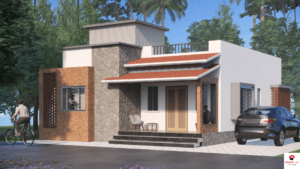When it comes to constructing buildings, compliance with building codes and regulations is of utmost importance. One crucial aspect that falls under regulatory scrutiny is the plinth height. The plinth height refers to the distance between the ground level and the floor level of a vastu for home plan. It plays a significant role in ensuring structural stability, protecting against various risks, and meeting specific regulatory requirements.
In this blog, we will delve into the intricacies of plinth height and explore its significance in building codes and regulations. We will examine the reasons behind its regulation, the factors influencing plinth height requirements, and the steps necessary to meet regulatory standards. Understanding these aspects is essential for architects, builders, and homeowners to ensure compliance, safety, and adherence to local building regulations.
Understanding Plinth Height:
The plinth height serves several purposes in building construction. It helps protect the building from moisture, flooding, and seepage. It also provides a barrier against pests and insects. Additionally, the plinth height plays a role in maintaining the structural stability of the building by providing a solid foundation and minimizing the risk of settlement.
Building Codes and Regulations:
Building codes and regulations vary across jurisdictions, but they typically specify minimum and maximum plinth height requirements based on factors such as the flood zone, soil conditions, climate, and building type. These codes aim to ensure safety, durability, and environmental sustainability in construction projects.
Determining Plinth Height Requirements:
Consult local building codes and regulations to determine the specific plinth height requirements for your project. Factors to consider include the flood risk level in the area, the building’s proximity to water bodies, and the local soil conditions. Understanding these requirements is crucial to ensure compliance and avoid potential legal issues or safety hazards.
Engage with Architects and Structural Engineers:
Working with experienced architects and structural engineers is essential when designing and constructing a house plan design. They have the expertise to assess site conditions, analyze soil reports, and determine the appropriate plinth height to meet building code requirements. Collaborating with professionals ensures that your project meets regulatory standards and mitigates risks associated with improper plinth height.
Foundation Design and Construction:
The plinth height is closely tied to the foundation design of the west-facing house plan with vastu. A robust foundation is essential to support the structure and withstand potential loads and forces. Engaging with structural engineers who can design and oversee the construction of a stable foundation that complies with building codes and supports the required plinth height is crucial in the house plan design.
Waterproofing and Drainage Considerations:
Proper waterproofing and drainage systems are integral to preventing water infiltration and flooding risks. The plinth height should incorporate measures such as damp-proof courses, water-resistant materials, and appropriate slope gradients to channel water away from the west-facing house plan with vastu. Compliance with building codes ensures that these systems are appropriately designed and implemented.
Regular Inspections and Approvals:
During the construction process, regulatory authorities conduct inspections to ensure compliance with building codes and regulations. Engage with local authorities and obtain the necessary permits and approvals at each stage of construction. Regular inspections provide an opportunity to address any non-compliance issues and ensure that the plinth height meets the required standards.
Ongoing Maintenance and Compliance:
After the completion of construction, ongoing maintenance and monitoring of the vastu house plan building’s plinth height is essential. Regular inspections, repairs, and maintenance of drainage systems, waterproofing measures, and the building’s foundation help maintain compliance with building codes and ensure the longevity of the structure.
Plinth height is a critical aspect of building construction that must comply with vastu house plan building codes and regulations. Meeting regulatory requirements ensures the safety, stability, and longevity of the structure while protecting against risks such as flooding, moisture, and settlement. Adherence to plinth height guidelines demonstrates a commitment to responsible and compliant construction practices.
Understanding the importance of plinth height and the factors that influence regulatory requirements is essential for architects, builders, and homeowners. By conducting thorough research, engaging with professionals, and obtaining the necessary approvals, one can ensure compliance with local building codes.
The collaboration with an online architect for your house design, best interior designer in Mumbai and structural engineers is crucial in designing a robust foundation that meets both structural requirements in a west-facing house plan with vastu and plinth height regulations. Their expertise helps navigate the complexities of soil conditions, climate considerations, and building type to determine the appropriate plinth height for the project.
Regular inspections and ongoing maintenance are vital to ensuring ongoing compliance with plinth height regulations. By actively addressing any non-compliance issues and conducting routine maintenance, the building’s structural integrity and adherence to regulatory standards can be maintained.
In conclusion, adhering to plinth height requirements is crucial for meeting building codes and regulations. It ensures the safety, stability, and durability of the structure while mitigating risks associated with moisture, flooding, and settlement. By following the steps outlined in this blog and working in collaboration with professionals, one can ensure compliance with regulatory standards, creating a safe and legally compliant building.








